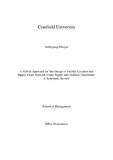JavaScript is disabled for your browser. Some features of this site may not work without it.
| dc.contributor.advisor | Skipworth, Heather | |
| dc.contributor.advisor | Palmer, Andrew | |
| dc.contributor.author | Meeyai, Sutthipong | |
| dc.date.accessioned | 2010-11-25T10:20:59Z | |
| dc.date.available | 2010-11-25T10:20:59Z | |
| dc.date.issued | 2009 | |
| dc.identifier.uri | http://dspace.lib.cranfield.ac.uk/handle/1826/4673 | |
| dc.description.abstract | In today’s extremely competitive marketplace, firms are facing the need to meet or exceed increasing customer expectations while cutting costs to stay competitive in a global market. To develop competitive advantage in this business climate, companies must make informed decisions regarding their supply chain. In recent years, supply chain networks have received increasing attention among companies. The decision makers confront the network design problem in different situations. In order to make decisions, especially in strategic supply chain management, decision makers must have a holistic view of all the components. Supply chain network design, particular facility location problems, is one of the most complex strategic decision problems in supply chain management The aim of this dissertation is to make an inquiry about the facility location problems and related issues in supply chain and logistics management, and the use of modelling approaches to solve these problems. The methodology is to construct a review protocol by forming a review panel, and developing a detailed search strategy with clear inclusion and exclusion criteria. In addition, the measurement for evaluating the quality of studies is presented with a strategy for extracting data and synthesising the methodologies. The search results show the background of the facility location problems, the importance and the basic questions of these problems. The taxonomy of facility location problems with eighteen factors is presented. The basic static and deterministic problems in facility location including the covering, centre, median and fixed charge problems are discussed. Also, the extension of facility location problems comprises of location-allocation, multi-objective, hierarchical, hub, undesirable and competitive problems. In terms of uncertainty, dynamic, stochastic and robust facility location problems are presented. Finally, strengths and weaknesses of different modelling approaches are discussed; importantly, gaps from the review process are indentified. Recommendations of future research are described; and the facility location problem to be addressed by the proposed research is shown. In addition, contributions of the proposed facility location problem are illustrated. | en_UK |
| dc.language.iso | en | en_UK |
| dc.publisher | Cranfield University | en_UK |
| dc.rights | © Cranfield University, 2009. All rights reserved. No part of this publication may be reproduced without the written permission of the copyright holder. | en_UK |
| dc.subject | Facility Location Problem | en_UK |
| dc.subject | Logistics and Supply Chain | en_UK |
| dc.subject | Optimisation | en_UK |
| dc.subject | Simulation | en_UK |
| dc.subject | Hybrid Approach | en_UK |
| dc.title | A Hybrid Approach for The Design of Facility Location and Supply Chain Network Under Supply and Demand Uncertainty: A Systematic Review | en_UK |
| dc.type | Thesis or dissertation | en_UK |
| dc.type.qualificationlevel | Masters | en_UK |
| dc.type.qualificationname | MSc by Research | en_UK |
